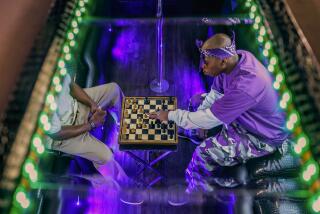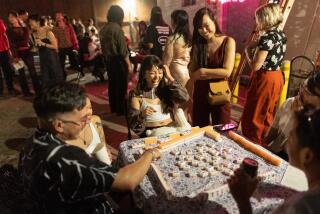The Way to Go
- Share via
The silence is broken only by the faint beep-beep-beep of timers. At long tables, players--one against one--bend over yellow boards marked in squares. Soon, strategies will begin to take shape as opponents position black and white stones at the intersections of the grid lines.
It is Saturday morning and, at a hotel near Los Angeles International Airport, more than 100 Go enthusiasts have gathered to compete for money, glory and ranking points at the two-day Cotsen Open, from which one player will emerge $1,000 richer.
Recording his every move on his laptop is Eric Cotsen, the 42-year-old Angeleno for whom this event is named in return for his sponsorship to the tune of about $23,000.
It is a surprisingly youngish crowd--indeed, two competitors are only 9--and, not so surprisingly, one with a significant number of Asian entrants. After all, Go is a game that originated in China 3,000, to 4,000 years ago and for centuries has been popular in Japan and Korea.
Most recently, the game figured in a scene from the Oscar-winning “A Beautiful Mind,” in which real-life Go enthusiast John Nash (portrayed by Russell Crowe) is exercising his gray matter in a game at Princeton.
The game is not exactly sweeping the country. Indeed, laments Ray Tayek of Lakewood, who’s been playing for 30 years (he’s wearing the “Go Eat Stones!” T-shirt), “It’s hard to compete with Nintendo and those whiz-bang-shoot-’em-up games. Go’s never going to be very popular.”
Still, there are pockets of players throughout Los Angeles County. Korean immigrants kicked things off, establishing a Go club in Koreatown in 1972. The New York-based American Go Assn. has 2,000 dues paying members. But Larry Gross of Culver City, the association’s western region vice president, says there are “hundreds of thousands” of players in the United States.
The association, waxing poetic, describes the game as “an intense meditation, a mirror of one’s personality, an exercise in abstract reasoning or, when played well, a beautiful art in which black and white dance across the board in delicate balance.”
In less abstract terms, this is what it’s about: competing for territory.
Still, Go players insist, it is a gentle game. Sure, both players are staking out their territory while putting the squeeze on the opponent. But “you’re not trying to kill; you’re trying to co-exist,” at least for a reasonable amount of time, says Gross. (He’s the one in the “Go for Yu” T-shirt). “With chess, you’re trying to kill,” and it’s curtains when you catch the opponent’s king.
Players, in turn, place their stones on the board. Once placed, stones are never moved unless completely surrounded by the opponent, at which time they are captured and taken off the board. When neither player can make a move, the game is over. The player who has taken the most territory wins the game.
With Go, each stone is identical in value, and there is no one essential territory to defend, as in chess. So the game undulates, with different patterns emerging as players think and rethink their strategies. It’s left brain and right brain--about making pretty shapes even while stalking your opponent. A blunder is a blunder, but it is not necessarily fatal.
Among players, the Koreans tend to be known as fierce fighters, Gross says, and the Japanese are more like boa constrictors, slowly putting on the squeeze. And the Americans? Gross laughs. “Elephants who come stomping in--a little more aggressive. Americans don’t tend to be as poetic as the Japanese.”
Only a handful of women are among the competitors in this tournament. “Unfortunate,” but not surprising, observes Gross, as perhaps only 15% of those on the U.S. Go circuit are women. Traditionally, he notes, this was a game played by samurai, the warrior aristocracy of Japan, when “the place of women wasn’t such that they would get involved.”
Ned and Joanna Phipps of Sonoma County are competing. “He and I are the strongest married couple” playing today in the United States, she says. “My first opponent today said he’d never played a woman. He was surprised that ‘for a woman’ I was so strong,” a comment that caused her to bristle. She lost, she added, “but it was close.”
One of a handful of active professionals in the U.S., Yi Lun Yang, 51, of West Covina emigrated 16 years ago from Shanghai, where he was also a pro. “I’ve made a really good life,” he’ll tell you. “I own two houses and have many cars.” (He charges about $25 a lesson and, he says, can produce a competent Go player in about 50 lessons).
Cotsen, who divides his time between homes in Westwood and Malibu, learned at the hand of Yang. “The flaws you have in your character are generally the flaws in your Go game,” says Cotsen, whose investments include the Princeton Review, which prepares students for test taking and helps them choose colleges. “I’m very ADD,” which creates trouble focusing. “When I do focus, I tend to hyper-focus” on killing a group of stones, he says, even though that loses the game.
Curtis Tang, 9, of Alhambra has just beaten his 54-year-old opponent in round one. He would go on to win four of his five games.
Older players “don’t scare me,” says Curtis, who was introduced to the game by his father. Curtis “at first didn’t like it that much” but discovered it was more fun when you win.
He placed fourth as an 8-year-old representing the U.S. in the junior division of the World Youth Go Championships last year in Maui, the best result ever for an American junior.
Go addicts can find someone to play on the Internet day or night. But there is no computer software that’s close to being able to defeat a top Go player as IBM’s Big Blue bested the world’s best chess player, Garry Kasparov, in 1997.
Indeed, a million-dollar prize was offered by the late Chinese industrialist Ing Chang-Ki to the creator of a computer program that could do just that. It expired with no winner. But the Intelligent Go Foundation is encouraging development of sophisticated Go software.
“We don’t have enough money to put up 1 million,” says foundation founder Bob Myers of Los Angeles.” But the foundation last year awarded $15,000 to the designer of the best software.
To Myers, Go is “a fish tank in which to watch your thoughts and emotions floating around like little goldfish. It’s a weird combination of mental, psychological and emotional.”
When the last stone was placed Sunday, the big winner was--no surprise--the Chinese-born ranking player in the field, Jie Li, 20, who is a business major at Foothill College in San Jose. It was deja vu--he won the Cotsen the last time it was held, in 2000.
He also bested a top-ranked professional in a game last year in San Francisco and is the cover boy on the current issue of American Go Journal. He thought he might use his $1,000 prize money to travel.
His reputation had preceded him to this event. Said Li, “My first opponent didn’t even show up.”


